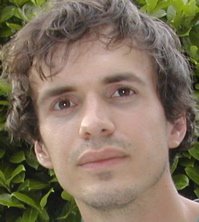Today I began my second week of teaching, and my first sessions with Class 4 and 5A. It's a challenge to keep up with all the different sign names. After trial and error from last week, I have a basic introductory first lesson in place. I start by introducing myself and the students, and then I sketch a map of America on the board, marking a dot in the heartland, near Chicago, where I was born and raised. After finishing university in Iowa, I moved to Portland, Oregon, on the west coast, and I tell the students that I lived there for 5 years. Then I moved to Baltimore (of interest to the students because it's near Gallaudet in Washington, D.C., the only all-deaf university in the world), where I completed my M.F.A. From the midwest to coast to coast.
Then I asked them what they wanted me to teach them. What did they want to learn how to draw? Everything from tigers to tears, villages to the Statue of Liberty.
I've also had the opportunity to tell them about Barack Obama's historic win as president of the United States. Yesterday, when I visited the school in the afternoon, I hung out with a half dozen of the older boys, who all had questions about America, including our new president. Did I like him? How old was he? Does he have children? Yes, he's 47, he has two children. Why did Islamic militants attack the U.S.? Wasn't Obama friends with the terrorists, one student asked. I couldn't answer the first question, but the second was an obvious no. Why was Abe Lincoln assassinated? I tried to expain as best as I could, with my limited Nepali Sign Language, the reasons for the Civil War.
Aside from their misconceptions about Obama, the students are excited about him. It's significant even here that our country elected a black man, and I think Nepalis sense a major paradigm shift, not just in America, but in this part of the world, too. While Obama's of a different race than Nepalis, he's of a similar hue. The students also want to know if Americans like Nepal, and I tell them that Americans know about Mount Everest and the tallest mountains in the world, but not much else. How many deaf people are there in America? And of course they want to learn American signs, too.
Teaching has been trial by fire, which I learned last week after the kids asked me to show them how to draw a dog. While I studied studio art in college, my experience was mainly with drawing people. Here I was, in front of more than twenty excited second graders, expected to draw a dog.
I've been trying to encourage creativity, so I showed them different ways to draw the ears-- floppy like Spot or pointy like a wolf? But my attempts to have them draw a dog using their imagination, and with several different templates, fell flat. I drew two cartoonish cross-eyes, and then a rat-like snout with whiskers. It was a terrible drawing, and I could hardly keep from laughing at myself. Meanwhile, the kids were dutifully copying my drawing exactly as I'd made it, holding up their notepads and asking for my approval. Still, I sensed some disappointment that I hadn't drawn much of a dog.
I was asked to teach this class on two days' notice, and only now, in my second week, am I beginning to formulate a plan. I want to teach them basic artistic techniques, such as shading, three-dimensional objects and perspective. A cylinder can become a vase, and a cube and pyramid a house. Cylinders and cubes can be as grandiose as castles. My eventual goal, if this is possible in two months' time, is to teach them to draw the human face and body using their knowledge of basic shapes, which is also made up of cylinders and spheres. I hope that I can use these techniques to teach them not to draw from memory but from observation and imagination.








.jpg)







.jpg)

.jpg)
.jpg)

.jpg)
.jpg)

.jpg)
.jpg)










